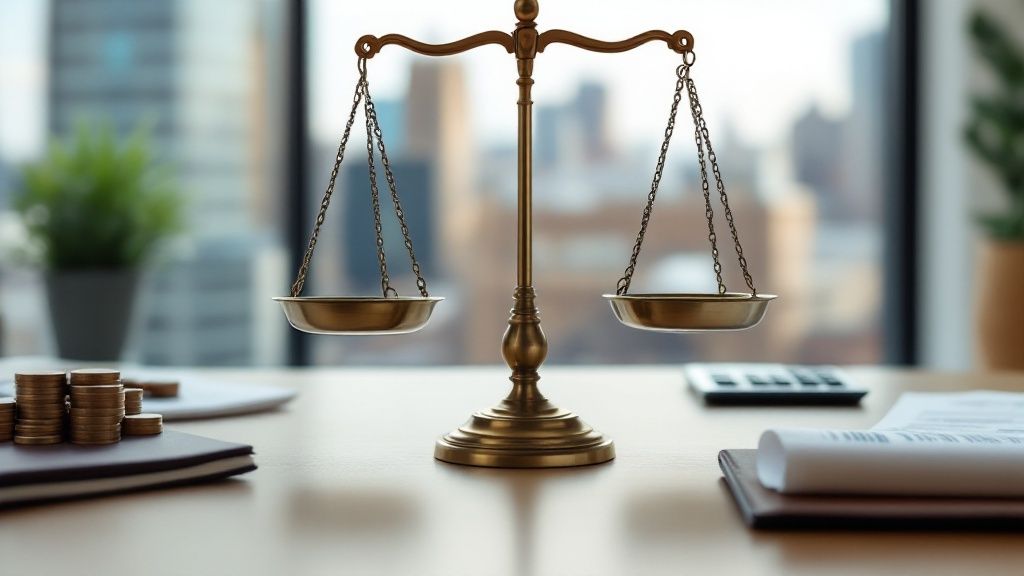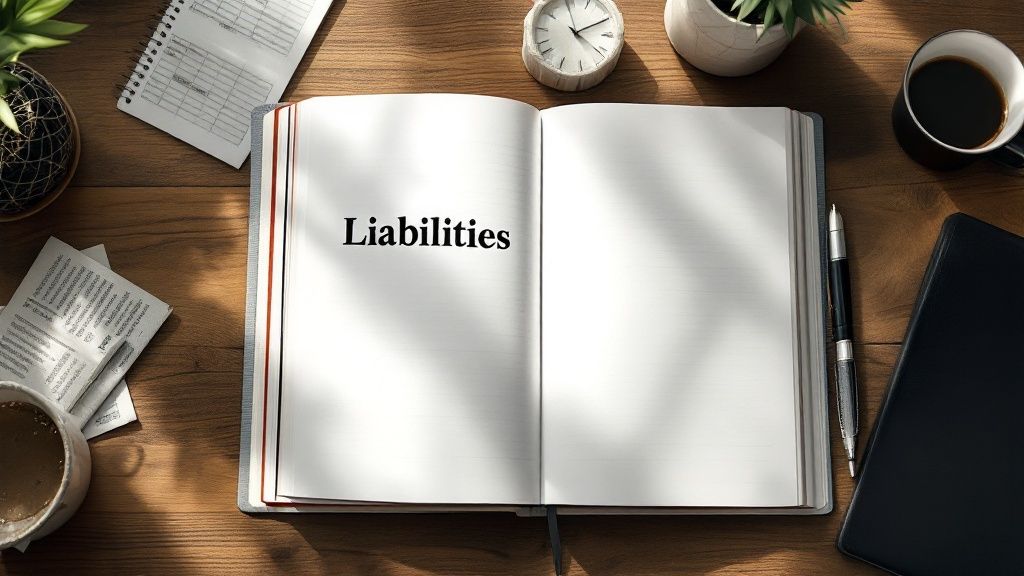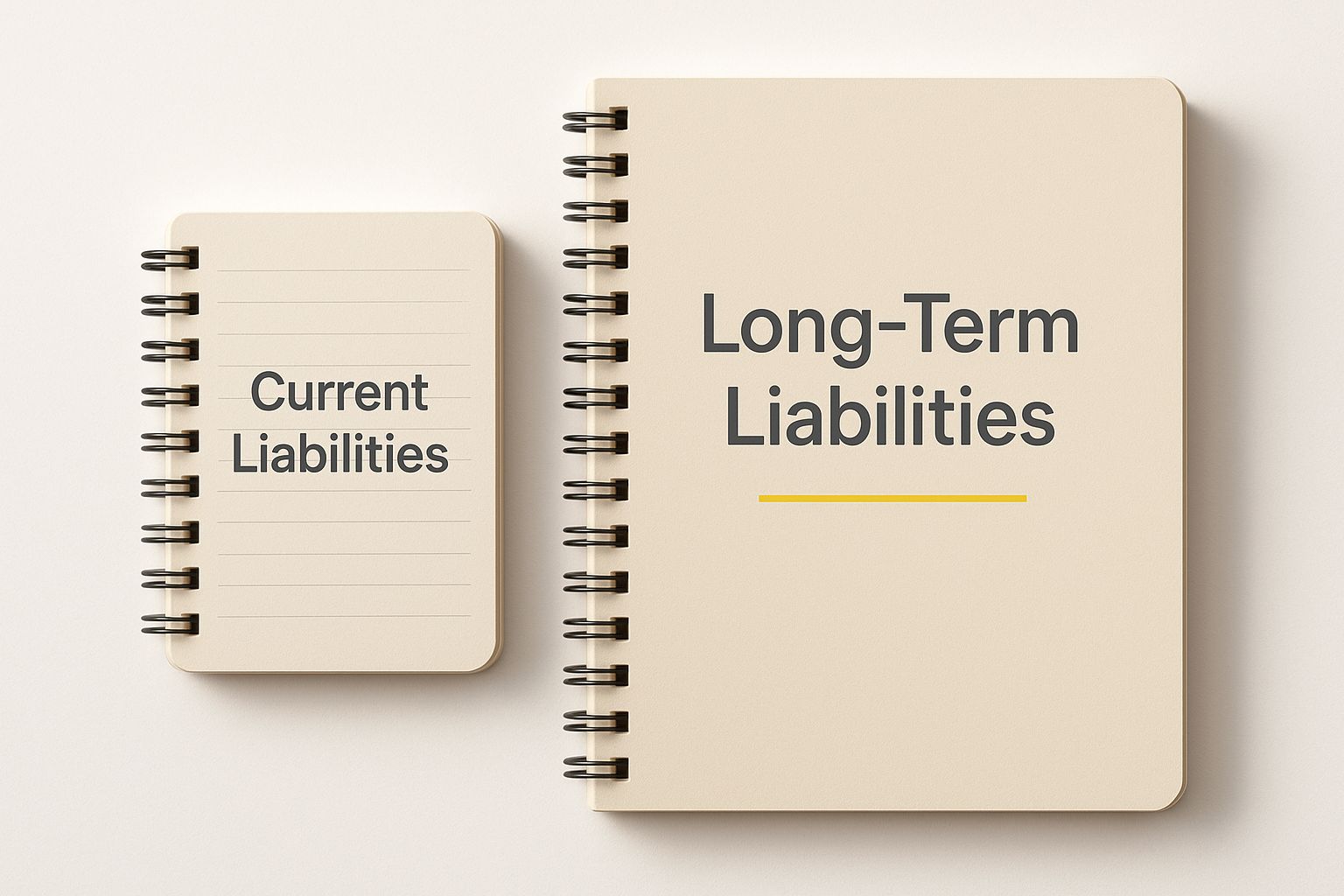
Let's be honest, the word 'liability' can sound a bit scary. For many new business owners, it brings to mind problems, risks, or something gone wrong. But in the world of business finance, that's not the case at all.
So, what are liabilities in a business? Think of them as any financial obligation or debt your company owes to someone else. They're essentially your business's IOUs – promises you've made to pay for something later, whether that's with cash, goods, or services.

Far from being a sign of failure, liabilities are a perfectly normal—and often essential—part of running a successful business in the UK. They are a tool for managing day-to-day operations and fuelling future growth.
Imagine you run a local bakery. You order flour from a supplier on a trade account. The moment you receive that delivery without paying cash on the spot, you've created a liability. You have the flour you need to bake, and you've simply promised to pay the invoice later. This is what keeps your shelves stocked and your cash flow healthy.
In simple terms, liabilities are what your business owes to others. They are the 'IOUs' that help you manage daily operations and fund long-term growth plans.
Getting to grips with your liabilities is key to understanding your company's true financial health. These obligations are woven into the fabric of your business, playing a vital role in several areas:
Ultimately, liabilities are a fundamental part of your financial structure. They balance against your assets and help paint a complete picture of your company's net worth. Without them, you're only seeing half the story.
Not all financial obligations are created equal, and when it comes to business liabilities, the biggest difference-maker is time. Liabilities are sorted into two main buckets based on when they're due: current and long-term. Getting this distinction right is crucial because it helps you separate your immediate financial pressures from your future commitments.
Think of it like your personal budget. Your monthly rent or electricity bill is a current liability—it's due soon and part of your regular financial cycle. A mortgage on your house, though, is a long-term liability, with payments stretching out over many years. That exact same logic applies to your business finances.
This image helps visualise the core difference.

As you can see, it all comes down to the repayment window. Current liabilities are all about the short-term, while long-term liabilities are about debts with a much longer lifespan.
Current liabilities are your short-term debts, specifically those that must be paid within one year or a single operating cycle. These are the regular, ongoing obligations that keep the lights on and your business running day-to-day. They’re a key indicator of your company's immediate financial health.
For a UK business, some classic examples include:
On the other side of the coin, long-term liabilities (also called non-current liabilities) are obligations due more than one year from the date on your balance sheet. These debts are usually tied to major investments or strategic financing that fuels your company's growth over time.
Long-term liabilities are strategic financial tools. They represent the investments made in your business's future, from purchasing property to funding significant expansion projects.
Examples of long-term liabilities include things like:
To make this even clearer, let's break down the key differences side-by-side.
Getting these categories right is a cornerstone of good financial management. If you’re juggling these figures and need a hand, professional bookkeeping services can make sure your accounts are always accurate and perfectly organised. This ensures you have a clear picture of both your immediate needs and your long-term financial stability.
Understanding business liabilities moves from theory to reality once you can spot them in your own accounts. These obligations are a normal part of doing business, and recognising them is the first step towards managing your finances effectively. Let's walk through some of the most common liabilities you'll come across.

Perhaps the most familiar liability is Accounts Payable. This is simply the money you owe to suppliers for goods or services you've received but haven’t paid for yet. Think of that invoice from your web designer or the bill from your packaging supplier—both are classic examples.
A close cousin to this is Accrued Expenses. These are costs your business has racked up, but for which you haven’t yet received a bill. A perfect example is employee wages. Your team works all month, earning their salary day by day, which creates an expense for your business. This builds up as a liability that you clear on payday.
Beyond your day-to-day operational debts, businesses often juggle liabilities tied to finance and customer payments. One of the biggest is usually a Bank Loan. Whether it's a long-term loan to buy new equipment or a short-term facility to manage cash flow, the amount you owe the bank is a clear-cut liability on your books.
Another crucial category is Taxes Payable. This covers any obligations owed to HMRC, such as VAT and Corporation Tax. As your business makes money, it also builds up tax duties that must be settled by specific deadlines. Keeping a close eye on this is vital; you can learn more about key tax duties in our guide on the VAT registration threshold.
A key liability to watch for is Deferred Revenue. This is a slightly unusual one. It happens when a customer pays you in advance for a product or service you haven't delivered yet. The cash is in your bank account, but it's not truly yours until you've held up your end of the bargain.
For instance, if a client pays for a six-month consulting package upfront, that entire payment sits on your balance sheet as a deferred revenue liability. Each month, as you deliver the service, you can then recognise one-sixth of that payment as actual, earned revenue.
Liabilities aren't just a running list of what you owe; they're a core piece of the puzzle that is your business's financial health. They sit right at the heart of the balance sheet, one of your most important financial statements. The balance sheet gives you a snapshot of your company’s financial position at a single point in time, and it’s all built on one simple but powerful formula.
It's known as the fundamental accounting equation:
Assets = Liabilities + Equity
Let’s break that down with an everyday example. Imagine buying a house. The property itself is your asset (what you own). The mortgage from the bank is the liability (what you owe). Your down payment, plus any capital you've paid off, is your equity (your stake in the property). In the end, the value of the house must always equal the mortgage plus your personal stake. It's a perfect balance.
That same logic applies directly to your business. On one side of the equation, you have your assets—things like cash in the bank, your equipment, and stock. On the other side are the claims against those assets. These are split into your liabilities (what you owe to suppliers, lenders, etc.) and your equity (what you and any shareholders actually own).
So, liabilities act as a counterbalance to your assets. They show how much of your company's resources are funded by borrowing, versus how much comes from the owners' investment. A business with very high liabilities compared to its equity, for instance, is likely relying heavily on debt to keep the lights on.
Getting your head around this relationship is essential for making smart financial decisions. It helps you gauge risk, track performance, and give a clear picture to potential lenders or investors. Keeping these financial statements accurate isn't just good practice; it's a legal requirement. Our team can help manage your year-end accounts to make sure everything is precise and fully compliant. Ultimately, understanding where liabilities fit in is the key to knowing your business's true net worth.
Knowing what liabilities are is one thing, but actively managing them is what really separates a thriving business from one that’s just treading water. If you get it wrong, poor liability management can quickly suffocate your cash flow, making it a struggle to pay suppliers, your staff, or even yourself.
It’s a bit like trying to run a marathon with weights tied to your ankles—every step forward takes far more effort than it should.
A heavy debt load also acts as a huge red flag for potential investors and lenders. When they scan your balance sheet, a high level of liability screams risk. This can shut the door on securing the very funding you need to buy new equipment, expand your team, or jump on growth opportunities.
Letting liabilities spiral out of control isn't just a theoretical problem on a spreadsheet; it has very real, tangible consequences. According to recent Companies House data, there were 24,229 insolvent liquidations in the UK last year.
This sobering figure shows just how much financial pressure businesses are under when their obligations outstrip their assets or cash flow. While not every case is purely down to debt, these numbers from the latest UK company insolvency trends underscore how critical sustainable financial management really is.
Effective liability management isn't about avoiding debt altogether. It's about using it strategically as a tool for growth, without letting it become a threat to your company's stability and future.
Ultimately, smart management acts as a financial shock absorber, protecting your business during economic downturns and positioning it to thrive when conditions are good. It gives you the flexibility to navigate challenges and seize opportunities as they arise.
Getting a clear, regular picture of your financial standing through management accounts is key to improving business performance and making the kind of informed, strategic decisions that drive growth.
Not every financial threat to your business will show up neatly on the balance sheet. In fact, some of the most significant risks are the ‘hidden’ ones, what we in the finance world call contingent liabilities.
Think of these as potential obligations that only become real debts if a particular event happens down the line. They're the financial ‘what ifs’ of running a business. A pending legal dispute, a product warranty claim, or an unexpected fine from a regulator are all perfect examples. While they aren't definite debts yet, ignoring them can lead to sudden, serious financial trouble.
This is where smart risk management comes in, and business insurance is your most important tool. It acts as a financial safety net, specifically designed to cover the costs of these unforeseen events. The sheer scale of these potential liabilities shows just how essential insurance is for UK businesses.
The UK's insurance industry pays out a staggering £22 million every single day in business claims. Of that, liability-related claims account for an average of £7.6 million daily, with £1.8 million of that going towards employers' liability alone. You can dig into more UK business statistics on Money.co.uk to get the full picture.
A contingent liability is a potential financial obligation that hangs on a future event. Proactive risk management, mostly through insurance, is the best way to shield your business from these uncertain threats.
This protection is absolutely critical for obligations like employers' liability, which covers things like workplace injuries and your legal duties as an employer. This also includes your responsibility for pension contributions—another major financial commitment. To get a better handle on this, check out our guide on how to calculate employer pension contributions.
Here are a couple of common questions that often pop up when we talk about liabilities.
It’s easy to mix them up, but no, they're not quite the same thing. Think of an expense as the cost of doing business, like your monthly software subscription. A liability, on the other hand, is the obligation to pay for something.
Here’s a simple way to look at it: when you receive an invoice from a supplier, that creates a liability (what accountants call accounts payable). The moment you pay that bill, the liability is cleared. The expense was using the supplier's service; the liability was the duty to pay for it.
In theory, yes. In practice, it’s extremely rare for any active business. Even if you've steered clear of loans, you’ll almost certainly have short-term liabilities floating around.
Things like unpaid supplier invoices (accounts payable) or wages you owe your staff for hours they've already worked are perfect examples. These aren't signs of trouble; they’re just a normal, healthy part of the day-to-day rhythm of running a business and managing your cash flow.